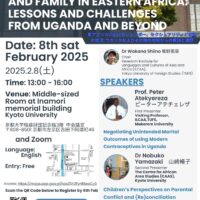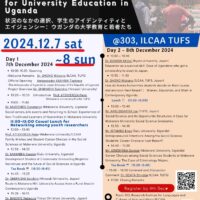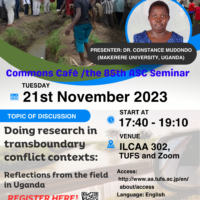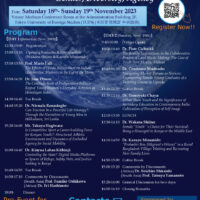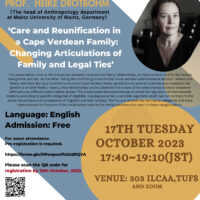On 16th February 2020, the research team on gender and sexuality held the 13th meeting on “African Potentials” organized by Wakana Shiino. The theme was “thinking of the condition of the LGBTI+ in Kenya and Uganda”. In this meeting, I offered the local lens to the LGBTI+ question. I explained how the pro/anti-homosexuality contentions play in/and outside Uganda, within/and in the sidelines of the LGBTI+ in-group. This was aimed to explain the homophobic status that has become systemic across the globe.
LGBTI+ activist Satomi Shimada of Rainbow Refugee Connection (RRCJ) made her presentation with image illustrations depicting gross bodily harm, killings, and other violations inflicted on LGBTI+ people with whom she interacted at Karuma refugee camp in Kenya. The images of physical violence that consumed the greater part of her presentation remained unrealistic to me not only as a native from East Africa but also as a person with law enforcement background. I learned later that such information is shared among and within LGBTI+ networks and is, most likely, inaccessible for heterosexuals that are unwilling to partake in such discussions. In this session, my contribution in this meeting appeared as a defensive position for a friendly heteronormative society which was equally far-fetched. Whilst the international representation of East Africa’s homophobia is overrated, the pervasive human rights abuses in African societies may not get obvious academic protection. I explained the entanglements of the strong gender hierarchy and associated heteronormativity in East Africa and how a strong alliance between local players and global pressure has been the center-stage for the emancipation of sexual minorities, not only in Uganda but also elsewhere in the world.
I highlighted that among researchers, an abstract line between heteronormativity and other sexual orientations has seemingly been drawn. Literature concerning the LGBTI+ community does not seem to attract researchers influenced by heteronormativity and, as such, there remains a divide. This has constructed a strong and resistant in-group and a very homophobic out-group that has resulted in a lasting contestation. The contentions include the dividing lines between the two sexuality dimensions and the question of whether the LGBTI+ community should be recognized as marginalized. Presenting at this meeting—and later writing my first ever work on sexual minorities—required that I seek the understanding of this condemned area and unwrap its academic potential. Even then, I have a responsibility to clearly declare my sexuality as a heterosexual lest I confront uncompromising societal negativities. The understanding of LGBTI+ dynamics in the political realms offers potentials for expansion of academic horizons on sexualized gender and sexuality in general.
Focus on East Africa, has been precipitated—in part—by the recent wave of criminalization of the sexual minorities. Uganda became a global item of discussion in this regard when the parliament enacted the Anti-homosexuality Act 2014. However, through the actions of the international community and the unquestionable elements of natural justice (procedural grounds), the Anti-homosexuality Act was overturned and declared inactive (not-in-force) by the courts of law. Although the Act of Parliament was overturned in a court of law in 2014, a new perception of insecurity emerged and reactivated a discourse of international humanitarianism. This characterized the LGBTI+ community as a humanitarian emergency, worth granting refugee status in LGBTI+ friendly nations in the Imagined West. In international politics, Uganda has since been characterized as an enemy of humanity, with state-inspired exterminations of sexual minorities. This media narrative has become generally understood to imply security crises in Africa’s homophobic states. Whether there are real threats to lives or not, there is a perception of a severe threat to life as an imagined reality, and that is what matters most. At the moment, there exist international narratives that depict the tragic end of sexual minorities through mass genocide. The entanglement of homophobically-charged local politics, international pro and anti-LGBTI+ resurgence, and the local sexual minorities’ quest for an operational space and recognition has constructed a complicated way to characterize perceptions and definitions of security.
I surmised that LGBTI+ plight is part of the social injustices that cannot be treated in isolation of structural marginalization and gross human rights violations for the greater majority of Ugandans. Security does not necessarily mean safety from physical violence but encompasses, in equal measures, the socio-political and economic injustices such a marginalized category may have to endure in a closed space. Also, the gap between facts and global opinions/perceptions increasingly demands new interpretations of security for sexual minorities. Perceptions of the extermination of sexual minorities seem to overcrowd the media and academic platforms. However, a deeper analysis of such media and the existing academic narrative reveals a bigger picture involving the global agenda for sexuality-related social transformation. There are also inconsistences between the local representations of LGBTI+ risk reporting and globally-inspired activism. Structural violence involving limited association, discrimination and lack of access to social equality, is more persistent and widespread than physical violence on LGBTI+ persons.
 en_US
en_US ja
ja